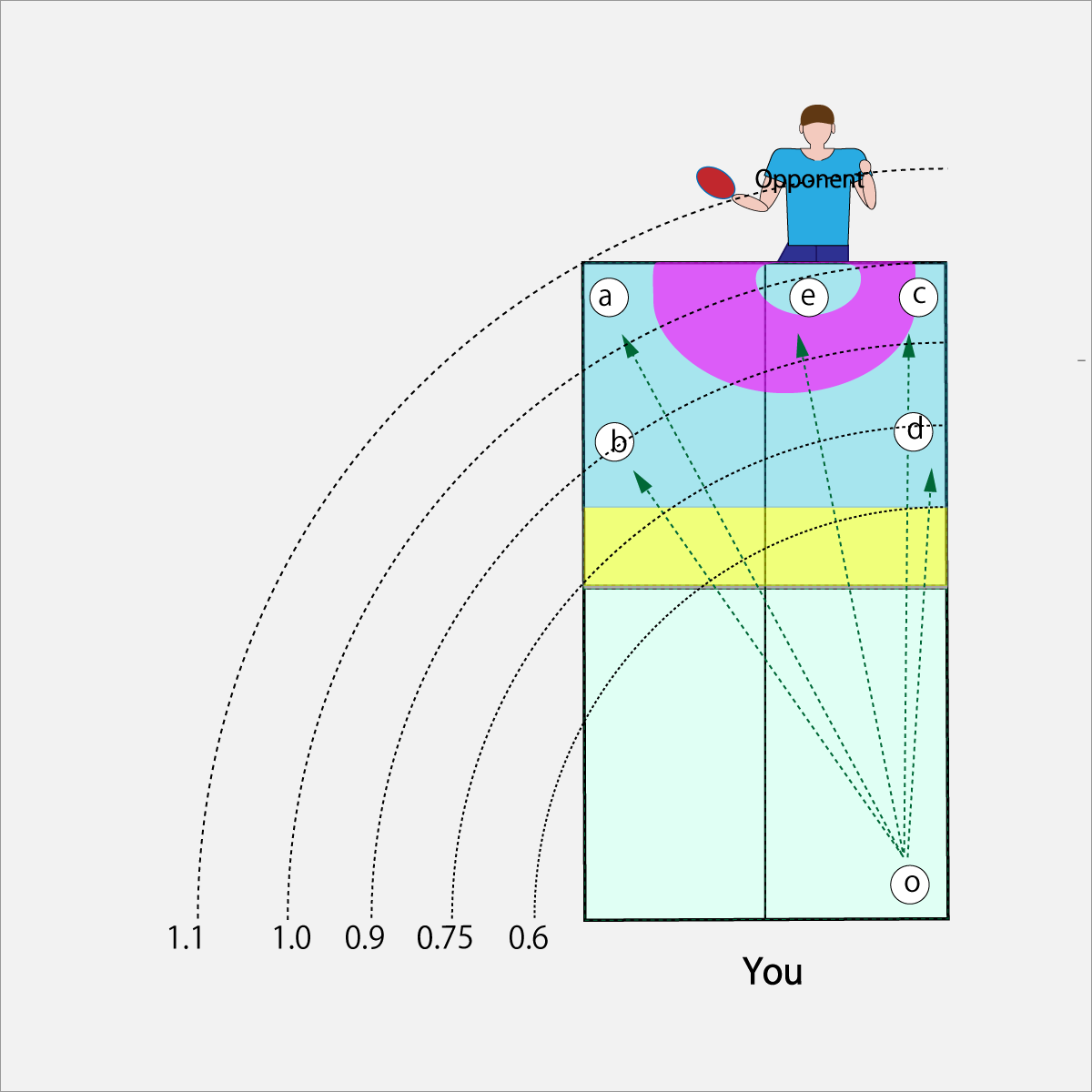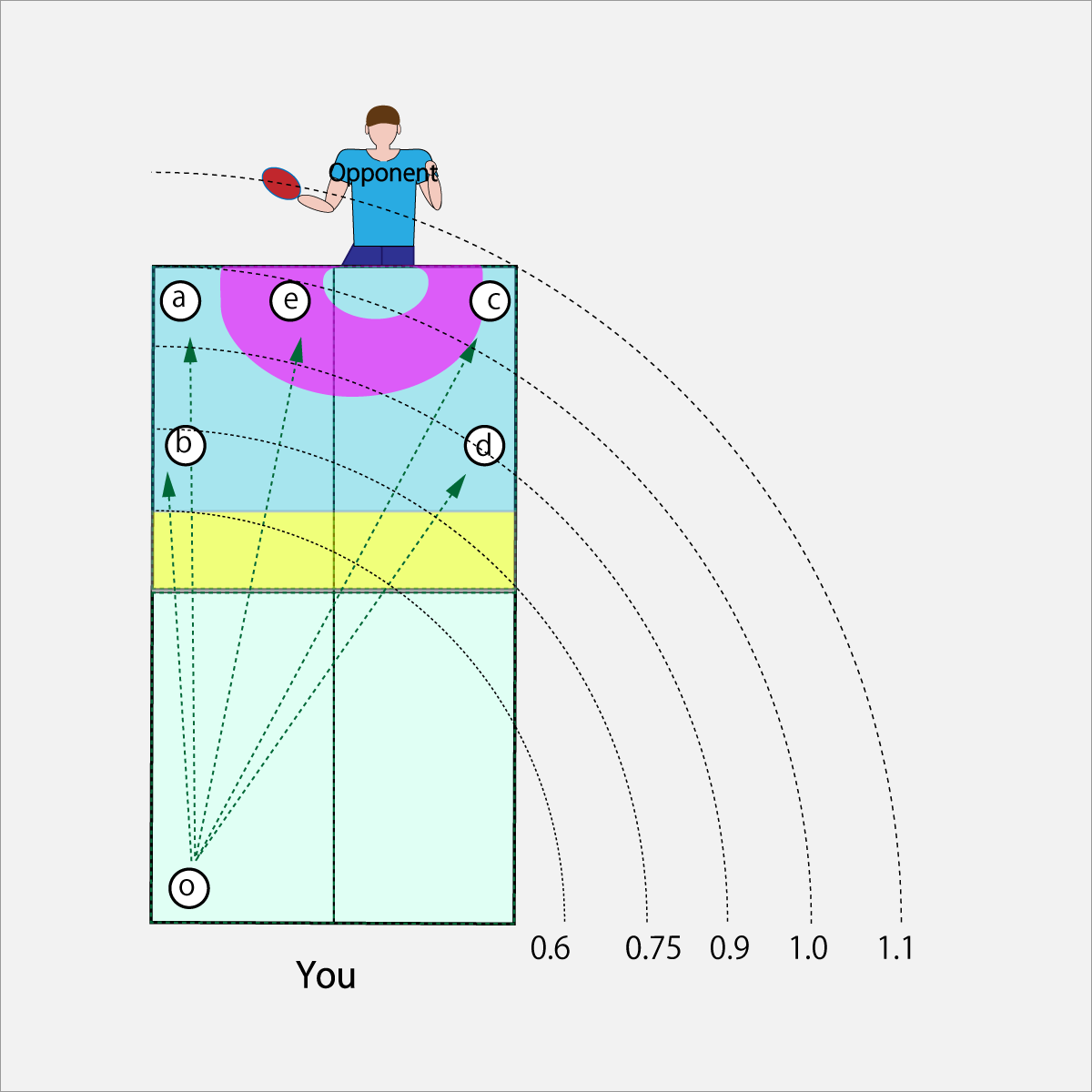Part 3. Swing Techniques Supporting the Basic Tactics
3.10. Hitting Direction and Force Range
Your sending direction or course in a rally, you need to memorize it because the next one will be referenced from at the previous one.
Rather it might be I should say as follows.
You have to memorize it in the attacking scenario, modifying the next from opponent's hitting point or ball kind.
You must always have the intended direction to where you send the ball and the whole scenario which you refer to.
Players have to image the next one, adjusting it from the difference between the actual and scenario images, The player, who is able to depict the definite image before the next swing, will dominate the game.
Following figures are superimposing the opponent's defense zone, and your offense course and the force rate at a certain moment.
The ball will be out from the table if you put on the same force rate with mindlessly to each offense course.
The appropriate force of each course is different and should not be the same. Adjusting the force is easy by adjusting the turning radius of the swing.
In addition, You should not send the ball into their defensive zone, and the zone is changing at every moment.
The defense zone varies depending on their competence, the more advanced player the range becomes wider.
Description of Following Figure
The blue zone is your offense zone. It is a high possibility you can get score if you can shoot the ball into this zone.
The pink zone is the opponent's offense zone. It is likely to receive counterattack if you shoot the ball into this zone.
The yellow zone is the risky zone where the net catches the ball.
The white background is, of course, the area where the ball jumps out from the table.
The distance from the point 0 to the point a is as unit "1" , the distance from the point 0 to each point is indicated by its ratio. Since the distance and force rate is proportional, this page deals that the force rate is to be the same as the distance from the point 0.
3.10.1. Hitting direction and force range of forehand

When the ball comes to your fore side, the swing will use forehand.
Hitting direction and force range
You will loose a point.
・When attacking the (a) using the force range of the (c).
・When attacking the (d) using the force range of the (a).
・When you attack the (a) or the (e), if the ball has entered the opponent's offense zone but your force range is appropriate.
・When you intend to attack the (c) or the (e), if your force range was shorter and the ball has entered the opponent's offense zone.
・When you intend to attack the (d), if your force range was shorter like the (b), the ball might be caught by the net.
For a successful attack, it is required to understand that the attacking course and the force range have very delicate relation. The force can be adjusted by raising the racket head to reduce the radius of gyration, shortening the contact time with the ball, suppressing the hitting speed, and consequently reducing the flight distance.
Scenarios of attack
(c)→(d)→(c)→(a)
(d)→(d)→(a)
(c)→(a)→(a)
(e)→(c)→(b)
Scenarios of attack is a lot, but the basic is that V direction is effective. Moving the opponent from side to side, punching out there making a time clearance.
3.10.2. Hitting direction and force range of backhand

When the ball comes to your back side, the swing will use backhand.
Hitting direction and force range
You will loose a point.
・When attacking the (a) using the force range of the (c).
・When attacking the (d) using the force range of the (a).
・When you attack the (a) or the (e), if the ball has entered the opponent's offense zone but your force range is appropriate.
・When you intend to attack the (c) or the (e), but if your force range was shorter and the ball has entered the opponent's offense zone.
・When you intend to attack the (d), if your force range was shorter like the (b), the ball might be caught by the net.
For a successful attack, it is required to understand that the attacking course and the force range have very delicate relation. The force can be adjusted by raising the racket head to reduce the radius of gyration, shortening the contact time with the ball, suppressing the hitting speed, and consequently reducing the flight distance.
Scenarios of attack
(a)→(d)→(a)→(c)
(a)→(b)→(c)
(a)→(c)→(c)
(e)→(a)→(d)
Scenarios of attack is a lot, but the basic is that V direction is effective. Moving the opponent from side to side, punching out there making a time clearance.